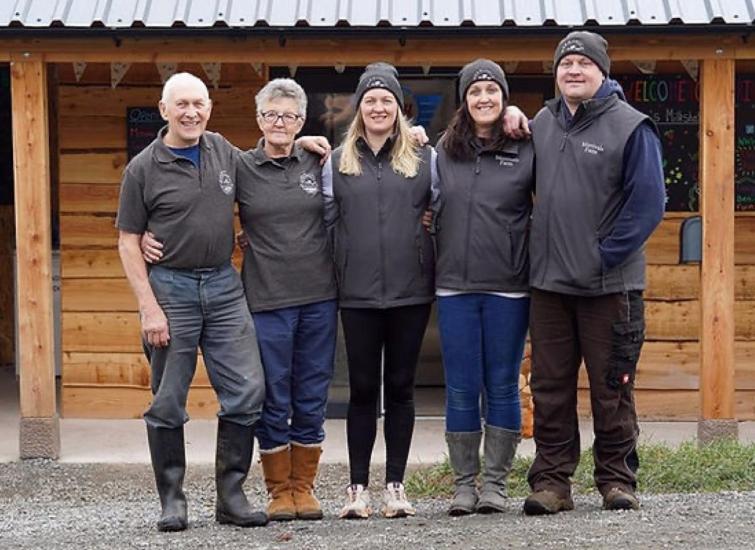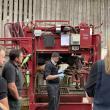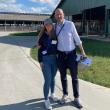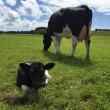Advanced Robot’s experience means they are always challenging me to get the best out of the cows, they maintain the herd’s health status whilst also improving performance.
Advanced Robot optimising milking robot efficiency on an organic farm
Using milking robots on an organic farm can be tricky, particularly during the grazing season. But one farming family is upping the ante with the help of the nutritionist, who has considerable robot know-how. British Dairying reports.

The Mason family farm at Merrivale Farm in Herefordshire, milking 155 cows through 3 Lely A4 Robots. The 175 herd of pedigree Holsteins produce 10,500 litres (305 day avg) of organic milk which is on a contract to Omsco as an antibiotic free herd. The milk is also sold as bottled milk and milkshakes through a vending machine installed on the farm 2 years ago, with another vending machine commissioned for the end of February 2023.
When Dylan Pinker from Advanced Nutrition started working with siblings Ben and Lucy Mason to provide support from their robotic division, the farm had been doing well. However, they needed to push things further and maximise the potential of their robots. The company’s robot division – Advanced Robot had been recommended to the Masons.
Ben Mason comments, “A neighbouring farmer had recommended Dylan and we soon understood that the company’s robot experience would be invaluable to us. Their technical ability and whole farm approach seemed to fit with our philosophy, and we started working with Dylan in 2020.”
“The challenge with robots for a grazing herd is to keep up the visits to maintain milk yields, the robots are always there for the housed herd but with a grazed herd you need to get the balance right."
Driven by feed
"That is to ensure the cow is hungry enough to keep visiting the robot where she is rewarded with a compound feed. She would then move to another paddock after a successful milking,” explains Mr Pinker.
The cows are grazed on an ABC system from March through to October and in order to maximise output, Dylan and the team re-evaluated the grazing strategy, and introduced the agrinet software program to aid with planning. Grass management was transformed, enabling the Masons to increase stocking density on the grazing platform, and allowing increased acreage to be used for silage ground. A designated grazing platform was introduced, with grass grazed to residuals of 1600 Kg DM/Ha. Ben comments, “the ABC system allows us to manage the grass and the cows more easily, creating a simple system with low labour costs.”
“It’s been especially hard for organic herds over the past couple of years to build forage stocks. We’ve had spells of wet and dry weather over the past couple of seasons which has meant grazing has been extremely challenging at times. It’s also meant creating a wedge of forage to last the Autumn and Winter months has been difficult.
Tight margins
"Organic feed costs are expensive," he adds. "Pair this with a low milk price in 2022 and margins have been very tight. So, managing the grazing system efficiently and getting more milk from forage has been paramount.”
The Masons are now seeing the results and currently achieve 4,300 litres per cow from forage. This has been in part due to the new grazing strategy but also in managing the robot settings. These are bespoke to this grazing herd with the milk access and feed tables settings changed accordingly throughout the season.
The Mason’s target four cuts of silage per year, with the aim of creating high quality forage, focusing on protein. Currently they are using a mix of Italian ryegrasses and, red & white clover for the silage grounds, and a mix of herbal leys & white clover’s for grazing. Turnips are also grown and are fed during late summer which target and counteract historically poor grass growing conditions.
Wholecrop is a barley and pea mix, under sown with a red and white clover, allowing the cows to graze post-harvest and increasing potential for milk from forage.
The wholecrop provides a great fibre source to compliment the high protein grass and fodderbeet, which is grown as an energy source for the winter.
“We’ve achieved the target of 2.8 visit average whilst grazing with the ABC system. Dylan has helped us improve our grazing management focusing on hitting the residuals on the grazed grass. Efficiency has been increased by decreasing the grazing platform and allowing more grass to be silaged. We also increased the stocking density to increase milk per acre,” says Ben
“It’s really important to maintain a high health status for our herd whilst we were making these changes and improving visits and building forage stocks aren’t the only areas that Dylan and the team have been able to improve.”
The Masons were having a small number issues with metabolic diseases in the fresh cows as a result of the transition period. Dylan introduced a new dry cow diet, using chopped straw and hay with a bespoke dry cow mineral to provide a high fibre, low energy diet. This helped with increasing intakes and ensured the cows weren’t over conditioned. The farm is now seeing very few milk fevers or retained cleansings.
Fresh cow performance
Fresh cow performance has also substantially increased which is having a knock-on effect for the subsequent lactation. For the milking cows, Dylan also adjusted the diet to maximise protein efficiency.
Typically grass is high in rapidly degradable protein which is difficult to utilise well in the diet. The addition of Novatan, a feed additive within the mineral, which encompasses excess degradable protein from the grass, allows this protein to be used by the cow, rather than being lost to the environment as waste nitrogen. This significantly increases protein efficiency, therefore increasing milk production, and reducing environmental footprint. A PMR buffer is offered at the robot sheds whilst grazing, including forages if grass is short, with compound fed year round in the robots and a meal during the winter depending on protein levels.
Overall herd health has improved and the table below demonstrates how they’ve been hitting their KPI’s:

Mr Mason concludes, “We’ve been happy to have Dylan and Advanced Robot join our team, we are really starting to see the benefits of their experience, we also like their whole farm approach that is already pushing for more improvements this year.”
Further planned improvements include looking to introduce alternative crops to decrease the need for bought in feeds, scrutinising organic raw material costs, improving heifer performance and supporting the Merrivale Milk brand in Herefordshire.
〈 BACK




